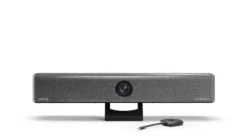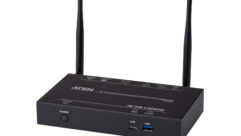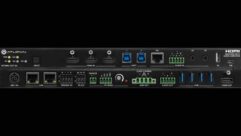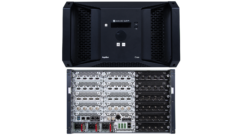Presentation Panoply
May 1, 2003 12:00 PM,
Mark Mayfield
If you really drill down to the essence of your business — any business, any industry — at the core of success or failure is the quality of communication. The same is true for your customers; whether you specialize in corporate boardrooms, performance spaces, houses of worship, commercial environments, or any other application, the quality of your contribution has a direct impact on the quality of your clients to communicate to their customers. The quality of the communication is dependent on the quality of the presentation of information, which is, in turn, dependent on the specific tools and their implementation in the final installation.
You can group presentation technology into two main classes: technology used for the creation of content and the technology used to deliver that content. Most of our businesses are primarily concerned with the delivery of content (whether live or prepared/stored), so this article will focus on the technology used for the actual delivery of your client’s presentation.
QUALITY IN, QUALITY OUT
This is a much kinder (and positive) way of stressing the importance of beginning with a quality source; you are probably thinking “Garbage in,…” However you choose to say it, this adage is true whether a presentation system is designed for live music or a formal business presentation. Although the focus is on delivery systems, it is important to recognize the input source. Most of the popular commercially available presentation software packages allow a fairly nontechnical end-user to prepare visually outstanding presentations. The most common ones are available from Microsoft (PowerPoint), Lotus (Freelance Graphics), Astound, and Corel. Besides incorporating text and images, most packages also incorporate some degree of animation, video, and audio. By far the vast majority of presentations are delivered by laptop, even in permanently installed systems. Microsoft’s PowerPoint seems to be the industry standard, however, with more than 300 million registered PowerPoint enabled computers driving an estimated 30 million presentations per day.
IT’S SHOW TIME
It wasn’t that long ago that presentation technology was limited to overhead projectors and slide shows. Now that slide shows are most often created in software, the focus is on electronically projecting or displaying the images from a PC. Although there are still a few 35 mm slide holdouts out there, the range of product choices for displaying images has expanded considerably.
Plasma monitors accept both data and video signals and can therefore be used as computer or standard video displays. Consumer and commercial demand for these ultrabright screens are driving prices down and quality up. Plasmas are becoming a popular presentation surface for many boardroom and display applications.
Interactive white boards are becoming more common in presentation systems and continue to be an area of new formats and approaches. An interactive white board requires three pieces of equipment: a computer, a projector, and a touch-sensitive white board. The computer is connected to both the projector and white board, and the projector displays the computer screen image onto the board. By pointing at active elements on the board using your finger or an appropriate electronic pen as a mouse, the computer can then be controlled from the board. A low-cost alternative is the infrared add-on (one size fits all) to an ordinary white board that basically allows the board to become an electronic copy board.
Recently, Hitachi Software Engineering America’s Interactive Communications Group announced two new members of its StarBoard family of interactive white boards, the Model F-60 (60 inch) and Model F-75 (75 inch). StarBoard interactive white boards and their associated software permit presenters to run computer applications and add freehand annotations to the graphics projected on the white-board surface using simple pen-type devices and dry-erase markers. The annotated data can be saved for later review and distributed in a variety of formats, including HTML, JPEG, BMP, and PNG. The systems incorporate infrared- and ultrasonic-sensing technologies. Sensors for pen movement are not embedded in the white-board surface, making the system reliable and providing for a fast-tracking, “think-time” responsiveness. First customer shipments are scheduled for the middle of 2003.
With the prevalence of PowerPoint in the business presentations world, it’s no wonder that accessory products continue to proliferate in the marketplace. The new Egan PowerX interactive touch screen is one such product; it’s designed to work specifically with PowerPoint and requires no additional learning of software applications. The PowerX screen connects directly to a PC and allows the presenter to operate all PowerPoint commands at the screen.
Smart Technologies’ DViT was just introduced at NSCA Expo in Dallas. DViT is a new way to create touch-screen control on any projection surface. A set of proprietary digital cameras and sophisticated software determine the contact location and translate it to your computer as mouse activity. No special pen tools are required because the technology can detect any object within view. DViT technology also requires no active, layered screen because the digital cameras are in a product’s corners, not in the surface. It’s ideal for rear-projection and plasma systems that demand high-quality, clear images. The rear-projection Smart Board 3000i and Smart Board for plasma displays interactive white boards currently feature DViT technology.
EMERGING DISPLAY TECHNOLOGY
In 2002 Sony announced a new display technology that may give DLP a run for its money. Grating Light Valve (GLV) display technology was originally developed by Silicon Light Machines, but Sony has licensed the technology for development in projection systems. It uses micro ribbon array (one-dimensional micro mirrors) that enables projection of high-quality, large-size images. Differing from other devices that use a two-dimensional (vertical and horizontal) structure, GLV technology employs only lined micro mirrors, enabling a much simpler device structure. According to Sony timetables, GLV-based products should be on the market very soon. Products are expected to target digital cinema as well as other high-output presentation applications.
As front-view display technologies continue to decline in price and increase in image size, large-screen plasmas, LEDs, and LCDs are becoming a viable alternative to projectors for larger conference room applications. Currently, the largest plasma display is the 63-inch PPM63H1 from Samsung Electronics. But in the past few weeks, NEC has introduced a technology to get an 84-inch image with a bundled solution. The PlasmaSync 84VP4 consists of four matrixed PlasmaSync 42VP4 plasma displays with a progressive-scan driving method and a high native resolution of 1,706 by 960.
NETWORKING AND CONTROL TECHNOLOGY
Just like almost every other area of technology, presentation systems are being influenced by the wireless revolution. Interlink Electronics recently announced the newest product to unleash the business presenter, the VersaPoint Communicator. The Communicator is a single-input device capable of wireless text entry, mouse navigation, and handheld presentation control that connects through a USB port. Integrating the keyboard, mouse, and handheld presentation controller, the Communicator’s USB receiver provides 64 radio-frequency address combinations to automatically filter competing or ambient RF signals and operates from as much as 30 feet from the host PC.
Like every other area of our business, networking has become a major theme in presentation environments. Networked A/V simply means that many of the projectors, monitors, audio and video mixers, and other peripheral equipment found in a typical conference room will all have unique IP addresses and thus be remotely controlled and monitored. Most projectors and displays are incorporating networking functionality in their product designs. Even if your device does not have built-in networking, companies like Extron Electronics are now offering tools to make almost any device “networkable.”
The increasing number of applications for the PDA is finally crossing over into the business presentations market. Several companies are marketing conversion systems that allow PowerPoint-type slide shows to be sent from a PocketPC- or Palm-based PDA directly to a projector through simple VGA connection. Boxlight’s new Projector Director is a wireless application that allows projector control from any PDA running PocketPC, and it works up to 300 feet away with most existing projector brands.
There is a lot to look forward to in presentation technology. For systems integrators, pro A/V installers, and professional presenters, the trends of converge and pace of technological advances promise that the process of communicating will continue to be more exciting, involving, and effective.
Mark Mayfield is editor of S&VC.
For More Information
Astound (Genesys Conferencing)
www.astound.com
201
Boxlight
www.boxlight.com
202
Corel
www.corel.com
203
Egan TeamBoard
www.eganpowerx.com
204
Extron Electronics
www.extron.com
205
Hitachi Software Engineering America
www.hitachi-soft.com
206
Interlink Electronics
www.vpcommunicator.com
207
Lotus/IBM
www.lotus.com
208
Microsoft PowerPoint
www.microsoft.com/powerpoint
209
Smart Technologies
www.smarttech.com
210
Sony
www.sony.net
211
Ž Circle this number on Reader Service Card or visit freeproductinfo.net/svc










